Two models lead the way to Santa Fe
By John Gilbert
PARK CITY, UTAH — Maybe it’s simply a translation issue, from South Korea to the United States, but the Santa Fe has never been introduced in Santa Fe, New Mexico. Hyundai also has a compact SUV named Tucson, which has never been introduced in Arizona. Go figure.
Nobody, however, is pleading for geographic logic in opposition to the site of Park City, Utah, where the 2013 Santa Fe Sport was introduced, complete with side trips to Sundance and the Olympic Park training facility.
In setting the stage for the increased luxury of the vehicle, we were dropped off 45 minutes west of Salt Lake City at the luxurious Montage Resort, nestled up in the trees at 8,347 feet of mountain altitude. It was the perfect place to show off the ability of the 2013 Santa Fe Sport’s turbocharged 2.0-liter engine, which easily coped with such a high-altitude drain on power.
The decidedly upscale revision to the Santa Fe has a flashy, bright chrome grille serving notice that its third generation intends to show its maturity by stepping above and beyond the subtle but efficient current model to become two vehicles in one.
The 2.0-turbo scored well in all maneuvers sending the Santa Fe Sport across some twisting mountain roads, and some rougher gravel back roads, although we didn’t do any off-roading that would qualify as being worse than a rural Northern Minnesota driveway. We only got the chance to drive the Santa Fe Sport with its 2.0-turbocharged 4-cylinder engine, while still to come is the same vehicle with the 2.4 GDI (gas direct-injection), both of those with compact 184.6-inch length. In a curious bit of name-calling, the actual vehicle called Santa Fe will stretch into an elongated 193.1-inch, three-row-seat version with a 3.3-liter V6, as it becomes a vehicle for all reasons. The new Santa Fe is not only a luxurious, upscale replacement of the current Santa Fe as the Sport, but it also grows to longer form to replace the larger Veracruz — an impressive top-end model, which will disappear in favor of the Santa Fe’s expanded intentions.
All Santa Fe models come with front-wheel drive or all-wheel drive, which is reflected in their price structure. The Santa Fe Sport 2.4 has a base price of $24,450 (FWD) and $26,200 (AWD); the Sport 2.0-Turbo runs from $27,700 (FWD) to $29,450 (AWD). Pricing on the elongated model will follow its introduction. Read more
Ram loads upscale features under familiar look
By John Gilbert
It takes a great truck to be competitive among full-size pickup trucks, and whether you examine trucks anywhere from Ford, Chevrolet, Ram, Toyota, to GMC, every one is impressive in capability. It takes something extra to break through that brand loyalty and lure a truck buyer to switch allegiances.
Dodge apparently had that in mind when it revised the 2013 Ram — which is no longer a “Dodge Ram” but simply a “Ram” nowadays. If it’s going to take special features and conveniences to attract truck buyers, the new Ram is loaded, from its kneeling stance for easy entry and exit via its adjustable ride-height 4-wheel air-suspension, to its high-tech V6 complement to the cylinder-deactivating Hemi V8, both operating through a very slick rotary-knob-controlled 8-speed transmission, to its inner comfort and connectivity.
Aiming at class-leading hauling, towing and fuel economy, the Ram is also out bolster its forceful reputation by setting new standards for interior comfort and futuristic Uconnect connectivity — places where the competitors might have previously had an edge.
From the outside, the Ram doesn’t look all that different from the current 2012 model. But look closely and you see that the big, bold crosshairs grille is now bigger and bolder, growing 30 millimeters taller, above a new lower fascia. The top-of-the-line Laramie Longhorn has what Dodge calls a “heroic” bumper that is one-piece, real steel.
Appearance-wise, the Ram offers various looks, with grilles that range from black, to body-color, to silver, and on up to the Laramie Longhorn, which has a very busy silver mesh behind the crosshairs, and which seem to me to be too fancy for a work truck, no matter how plush and feature-filled the interior might be. The mesh looks like an escapee from Range Rover might have designed the look. However, part of the Ram’s improved aerodynamics — a 0.36 coefficient of drag — is that slats close off the grille when cooling is sufficient to not need extra air, which further reduces the aero drag.
Speaking of real steel, the Ram, which came out in its current form in 2009, has an entirely new frame made with an increased amount of high-strength steel, which can be made thinner and still stronger to improve stiffness and reduce weight. The truck body, bumpers and cross-members are also stronger and lighter.
Under the hood, the 5.7-liter Hemi returns, but its less-potent 3.7-liter V6 partner has been replaced by Chrysler’s new 3.6-liter Pentastar V6. The engine, which actually replaced seven V6 engines ranging from good to mediocre, is the true star of everything Chrysler, Dodge, and Jeep put on the street these days, and its move into the Ram pickup is more than just impressive. It, alone, might be a deal-breaker for truck-buyers who don’t need the extra heft of a V8.
The 3.6 Pentastar, with its dual overhead camshafts and variable valve-timing, is built at a 60-degree-angle V, of high-strength diecast aluminum, with cast iron bore liners for the cast aluminum pistons. Six-bolt main-bearing caps and forged connecting rods assure strength, which is good, because the 3.6 churns out so much more power that for the first time, the Ram V6 is available with 4-wheel drive and even the humungous crew cab. It has 305 horsepower at 6,400 RPMs, and 269 foot-pounds of torque, peaking at 4,175 but maintaining 90 percent of full torque from 1,800 to 6,400 RPMs. The V6 has a high compression ratio of 10.2-1, but it will still burn regular fuel.
The 3.6’s 305 horsepower represents an improvement of 45 (8 percent) over the 3.7 — which will continue in the base Tradesman models — and the 269 foot-pounds are a 14-percent increase in torque. While Rams used to only use V6es in 4X2 trucks, the new 3.6 V6 has fuel economy figures of 17 city and 25 highway, and still accelerates 0-60 in 7.5 seconds, and hauls trailers up to 6,500 pounds.
For heavy-duty work, the 5.7 Hemi has variable valve-timing and cylinder shutoff, which idles four of the eight cylinders when cruising between 1,000-3,000 RPMs. It also can be selected with stop-start, which shuts off the engine during stops at lights or during work duties, and restarts smoothly and effortlessly when the driver steps off the brake. That requires a high-endurance starter and a DC-DC converter to keep the accessories going during stoppages, and a heavy-duty battery.
A vital part of the new Ram’s success is the new 8-speed automatic transmission, which made its debut in the Chrysler 300 and the Dodge Charger automobiles, and moves with very little modification into the Ram. It will replace the 4-speed automatic in the current V6, and will be moving up to the V8, where it will join the very good and quite-new 6-speed, and improve the Hemi’s fuel economy by an anticipated 10 percent.
The new 8-speed was designed by Germany’s ZF — pronounced “Zed-F” — and is now built by Chrysler under its own licensing in Kokomo, Ind. Having eight speeds means an expanded range of ratios, from 4.74 in first gear to 0.67 in eighth, where anything under 1.00 is overdrive. The wider ratios are an obvious advantage to both acceleration and high-speed cruising, and having more steps between the eight gears lessens the force of each shift for an improvement in shift quality. The inner sophistication of the transmission is best described by the fact it has over 40 shift maps, each of which are determined by computer, which reads engine speed, torque, and other driving demands, then selects the best ratio.
Shifting the transmission is done by a very Jaguar-like rotating switch. In every Jaguar, a small puck-like cylinder rises from the console, and you engage a gear, or park, by turning the thing. ln the Ram, the same sort of puck is located fixed on the center stack, in easy reach of the driver, and I found it more intuitive than the console switch on the Jag.
That’s a small part of the interior refinements in the Ram, which has redesigned cupholders, upgraded interior fabrics, with all media ports in the console’s center stack area. The Longhorn has real wood trim, of some sort of European open-pore wood, but the same guy who overdid the grille also might have been responsible for adding glare-attracting bright silver trim to the center-stack surround.
An optional display screen offers a full-color 7-inch view when you back up, and it allows viewing of trailer hookups while also including all pertinent trailer data.
The 3.6 V6 Ram is 130 pounds lighter than its predecessor, and the Pentastar V6 and the new 8-speed transmission account for 76 of those pounds. The 8-speed with the Hemi V8 is 30 pounds lighter than the 2012 Hemi with the 6-speed. Electric power steering operates the mechanical rack-and-pinion steering, and eliminates the need for a power-steering pump.
Price structure starts with the Tradesman 4X2 at $23,585; SLT models range from $28,345-$36,835; Sport goes from $33,030-$42,500; and the Laramie from $38,710-$48,515. Options, of course, including the air suspension, can boost all those prices. Production of the 2013 Ram started in August, and it will come out for the last quarter of 2012, a year when the Ram already is 23 percent ahead of 2011, year-to-date.
When the current Ram came out in 2009 was the addition of Ramboxes, the cleverly designed narrow little storage bins located in both sides of the bed walls, with hinged covers running along the top edge. It has been a popular feature, and it is enhanced on the new truck by being lockable at one touch, along with the tailgate, whenever the driver hits the key fob to lock the doors.
One of the 2013’s big features is the addition of air suspension, which allows adjustable ride height, something that is common among off-roading SUVs, but is unprecedented in pickups, which spend a lot of their working lives clumping over boulders and uneven land on ranches, farms, and on hunting expeditions.
The Ram can be adjusted to four heights, starting with an off-road setting that raises clearance by 2 inches; a lesser off-road setting increases ride height by a half-inch. The normal setting is for normal highway driving. Then there is the entry-exit setting, which causes the Ram to drop down 2 inches in ride height for easier climbing in or hopping out. A fifth mode that can’t be set is for aerodynamics, automatically lowering the Ram at 60 miles per hour to reduce aerodynamic drag.
As a final touch to show how far truck folks have come in recent years, the “next generation” Uconnect Access makes its debut, turning the Ram 1500 into a Wi-Fi hotspot. Voice-recognition can be activated, or coordinating with steering wheel controls, touchscreens and traditional controls, all of which offer occupants a variety of ways to access and operate the numerous gizmos. Access allows alternative ways to summon up and use all the various applications, including using the web, in case the optional 8.4-inch touchscreen seems inadequate.
Volvo S60 T5 upgrade deserves a medal
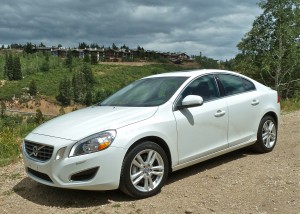
Volvo S60 T5 adds all-wheel drive for 2013, the easier to reach Utah's Stein Eriksen Lodge, in the background.
By John Gilbert
PARK CITY, Utah — Returning to the driver’s seat of a Volvo S60, and returning to Utah’s mountainous ski country were similarly familiar, particularly when both circumstances coincided with the late-July opening of the 2012 Olympics.
True, the 30th Summer Olympics — or the XXX Games, for those who prefer their competition X-rated — were starting in London, but the Winter Olympics were held in Salt Lake City in 2002 and remain riveted in memory because. I worked for the Olympic Committee at Salt Lake City, as supervisor of all the hockey information dispersed over the intranet service for the assembled hundreds of media from around the world. My wife, Joan, was a member of my six-person staff, and we worked tirelessly to produce swift and accurate news reports, even in the face of constant pressure by a National Hockey League official determined to turn the the Olympics into an NHL PR-event.
That’s another story. But when Volvo decided to introduce the final version of the popular S60 midsize sedan at Park City, where some of the 2002 ski events were conducted, it was a cinch, and it became a unique event when Volvo also asked auto-media types to bring along a spouse or other guest. The car as mainstream family vehicle was the obvious focal point, but we also were given the opportunity to visit Utah Olympic Park, to watch a unique presentation by the Flying Ace All-Stars, a group of past, present and future Olympic and world extreme ski-jumpers, and even to examine the bobsled, luge and ski jumping courses. Later we rode the Xtreme Zipline — the fastest way down from the mountaintop.
The S60 is Volvo’s mainstream staple, and between 2010 and 2012, Volvo has offered it as a high-performance turbocharged 6-cylinder, all-wheel-drive sporty vehicle, and as a more docile 5-cylinder, front-wheel-drive car.
Logic, and marketing pressure, left a large opening between those two extremes, and that is what Volvo is filling for 2013, upgrading the base 5-cylinder to a turbo all-wheel-drive model that covers the best of both worlds — performance and fuel-efficiency — while adding the all-wheel drive feature that now separates all-weather superstars from marginalized competitors.
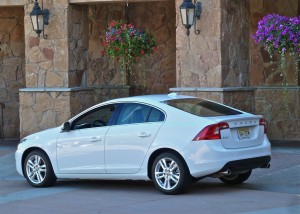
Forget the image of boxy Volvos; the new S60 T5 AWD is even at home as a Swedish car at a Norwegian's resort.
Our first impression was how free of wind or tire noise the car is, so S60 fans needn’t be concerned. But with the new model, you could say FWD might win the bronze, or even the silver, but it will take AWD to win the gold in areas where foul-weather driving is common.
First introduced as a 2001 model, the S60 was positioned between the larger luxury S80 and the more compact S40. A solid and steadfast all-season car with traditional Volvo safety benefits, and the most comfortably supportive seats in the industry, the S60 did right well in sales. A couple years later, Volvo added the S60-R, which transformed a nice family sedan into a turbocharged, all-wheel-drive, high-performance hot rod. Despite the obvious resemblance to a boxier heritage, it was my favorite Volvo ever.
After the normal five- or six-year plan for the redesigning, Volvo ran into an economic roadblock. It was 2007, and the bottom was falling out of the car market along with the rest of the economy. Ford, which owned Volvo at the time, convinced its Swedish affiliate to hold back on building the new S60 because of costs. Ford’s foresight helped it avoid bankruptcy bailouts that its top competitors, General Motors and Chrysler Corporation, required to remain in business. Ford later sold Volvo, Jaguar, Land Rover, and its majority share in Mazda. All are currently succeeding in the world marketplace.
Volvo is now owned by the Zhe-Zhiang holding company of China, which also owns Geely, a Chinese auto-maker. Volvo, which never compromised on making arguably the safest fleet of vehicles on the planet, moved onward and upward with the infusion of new money from a nation that has become the top automotive market in the world, as well as the manufacturer of current U.S. Olympic uniforms. Among the first orders of business was introducing the second generation S60, which hit the streets in 2010 as a stylish departure from the previous boxiness of Volvos. No more boxy corners, replaced by stylish and aerodynamic slopes and contours.
Surprisingly, Volvo surprised the auto world by introducing the S60 as an all-wheel-drive turbo 6-cylinder in 2010, with over 300 horsepower and torque figures, possibly as a determined effort to show that things were going to be different in Gothenberg. It wasn’t until six months later that Volvo followed with its high-volume, mainstream version of the car, with a 5-cylinder engine and only front-wheel-drive, with a lower price and better fuel economy. Earlier this year, Volvo expanded the input of Polestar, its high-performance electronic tuning affiliate, and created an even-more potent S60 T6.
That still left room for one more model — the T5. Turbocharging the 5-cylinder increases its power to 250 horsepower and 256 foot-pounds of torque, important to aid with the added all-wheel drive. Read more
Ford adds 1.0-liter EcoBoost to Focus
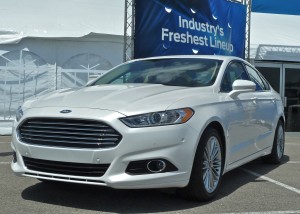
Ford hasn't yet introduced the 2013 Fusion, but it is the company's inspiration and technical halo car.
By John Gilbert
DEARBORN, MICH. — Smaller is big at Ford these days, and for 2013 the Dearborn company is expanding its highly successful EcoBoost technology to even smaller engines that will outwork larger ones while increasing fuel economy. Can you imagine a company that makes an impressive 6.2-liter V8 in its trucks will also be offering a 1.0-liter, 3-cylinder that propels a compact Focus with quick agility?
Ford Motor Company gained enormous amounts of respect and credibility when it foresaw the economic downturn and reacted strategically enough that it didn’t need the government loans that bailed out General Motors and Chrysler. Almost daily, I run into folks who have never been Ford fanciers but who now say they intend to examine Ford’s array of products before making their next purchase.
With that as background, dozens of automotive media types were herded to Dearborn for an advance check on the company’s 2013 vehicles, inside the secured walls of Ford’s Development Center.
I was able to fly in and out of Detroit on the day of the unveilings, so when I was whisked to the Tech Center, the groups of journalists had already started off in their four different groups. I was bused to the location of a lecture, but outside, I spotted a line of Focus sedans and hatchbacks on a tight little road-course, so I ambled over that way. Several Ford officials put me into a Focus and turned me loose. I zoomed away without a sound, because I was driving the new Focus Electric, with no gas-engine backup. Housing a new lithium-ion battery pack with permanent magnetic electric traction motor, the car had surprising quickness and, naturally, no emissions as well as no sound. The system is designed to produce 143 horsepower and 184 foot-pounds of torque, reaching a top speed of 84 mph, and go 76 miles on a full charge, which takes four hours on a 240-volt home-charging station. It will cost $39,200, and obviously is designed to challenge the Chevrolet Volt, Nissan Leaf, Mitsubishi Miev, Honda Fit Electric and all others.
That’s a lot of money for a Focus-size car, but that’s where costs are at these days in creating electric cars. Ford also has an electric-powered C-Max compact wagon, the Energi, being sold in Europe with pure electric, and coming to the U.S.
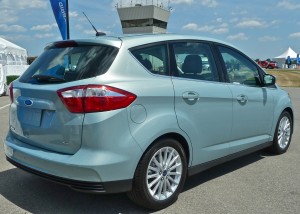
Based on the Focus, the C-Max will first come to the U.S. as hybrid or electric, but the 1.0 EcoBsoost is sure to follow.
Next, I climbed into a different Focus — I suppose you could say I reFocused — and took off around the same course, up and down some little hills and around some tight curves. This was obviously powered by a gas engine, but what an amazing gas engine! Designed and built in Europe, where it raked in all sorts of awards such as best new engine and 2012 engine of the year by the largest vote margin ever among 76 journalists from 35 countries, this engine is a tiny 1.0-liter in displacement, with only three cylinders.
It is the newest and smallest of Ford’s EcoBoost engines, which apply turbocharging to extract surprising power from reduced displacement. The Focus 1.0 comes in two versions, one with 98 horsepower that attains 58.9 miles per gallon, and the other with a more potent 123 EcoBoosted horsepower, getting “only” 56.4 mpg. Read more
Hyundai adds Veloster Turbo, Elantra Coupe and GT
By John Gilbert
SAN DIEGO, CA. — Hyundai has introduced so many impressive new vehicles in the last two years, you’d think the Korean auto-maker deserves to sit back and enjoy the rewards for a while. Instead, Hyundai is adding to its impressive array.
Since the 2011 Sonata, which thrust the company into the spotlight, two of the more interesting vehicles from Hyundai are the compact Elantra, which resembles a downsized Sonata and is such a coordinated and polished car it won the 2012 North American Car of the Year award, plus the unique and sporty Veloster, a three-door hatchback with sporty coupe flair and an accessible rear seat through a second passenger-side door.
Both the Elantra and Veloster were introduced as 2012 models. The Elantra as a remake of a car that was never an ugly duckling but was transformed into the automotive version of a stylish swan, while the Veloster is an all-new model. The Elantra more than delivered on its promise while rewriting the style and feature rules for compacts and also getting 40 miles per gallon. The Veloster was fun, but it promised performance that its high-tech and rev-able 1.6-liter engine had trouble delivering.
With both cars in their introductory year, Hyundai gathered the North American auto media at Torrey Pines, the plush resort in La Jolla, Calif., right near Hyundai’s U.S. corporate offices and design center, to unveil three new versions of the two cars — a turbocharged Veloster, and both a coupe and a five-door, wagon-like model of the Elantra.
The Veloster, Hyundai admitted, was a little shy on power. The 1.6 from the new Accent is a high-tech little jewel, with gas-direct-injection and variable valve-timing, and it is more than adequate for most consumers and most circumstances. But in the Veloster, if it is going to challenge such sporty icons as the GTI, Civic Si, Mini Cooper S, and Beetle Turbo, all of which slap a permanent smile onto the face of anyone driving them, more punch was needed. Hyundai responds promptly when it decides public reaction warrants it, and a twin-scroll turbocharger was the remedy.
A normal, single-scroll turbo picks off some of the exhaust flow headed out the tailpipe and redirects it to spin a turbine-wheel that sends a greater charge of air-fuel mixture back into the engine for improved burning and power. The system works, although there are some minor problems with varying exhaust pulses from different cylinders, which can increase back-pressure and heat and produce uneven airflow back into the cylinders. A twin-scroll turbo has two inlets in the turbine housing, separating the variant exhaust flow and minimizing back-pressure and creating a more pure and dense consistency to the forced-air feed going back into the cylinders. Read more


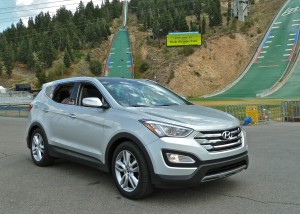
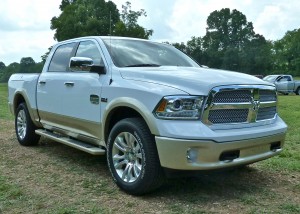
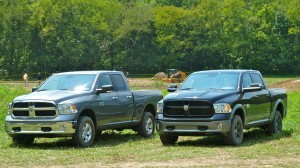
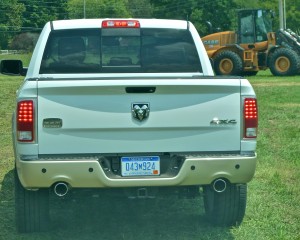
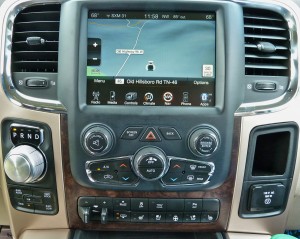
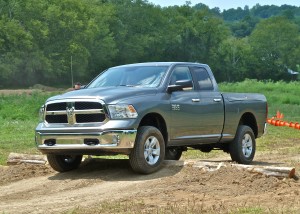
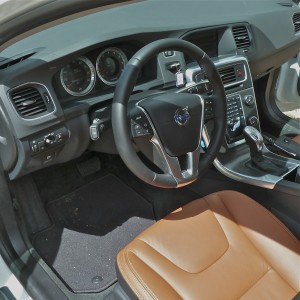
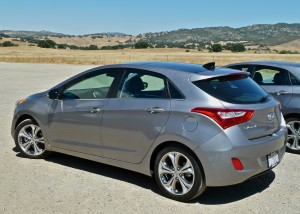
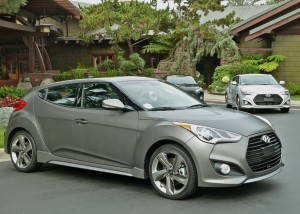
 John Gilbert is a lifetime Minnesotan and career journalist, specializing in cars and sports during and since spending 30 years at the Minneapolis Tribune, now the Star Tribune. More recently, he has continued translating the high-tech world of autos and sharing his passionate insights as a freelance writer/photographer/broadcaster. A member of the prestigious North American Car and Truck of the Year jury since 1993. John can be heard Monday-Friday from 9-11am on 610 KDAL(www.kdal610.com) on the "John Gilbert Show," and writes a column in the Duluth Reader.
John Gilbert is a lifetime Minnesotan and career journalist, specializing in cars and sports during and since spending 30 years at the Minneapolis Tribune, now the Star Tribune. More recently, he has continued translating the high-tech world of autos and sharing his passionate insights as a freelance writer/photographer/broadcaster. A member of the prestigious North American Car and Truck of the Year jury since 1993. John can be heard Monday-Friday from 9-11am on 610 KDAL(www.kdal610.com) on the "John Gilbert Show," and writes a column in the Duluth Reader.